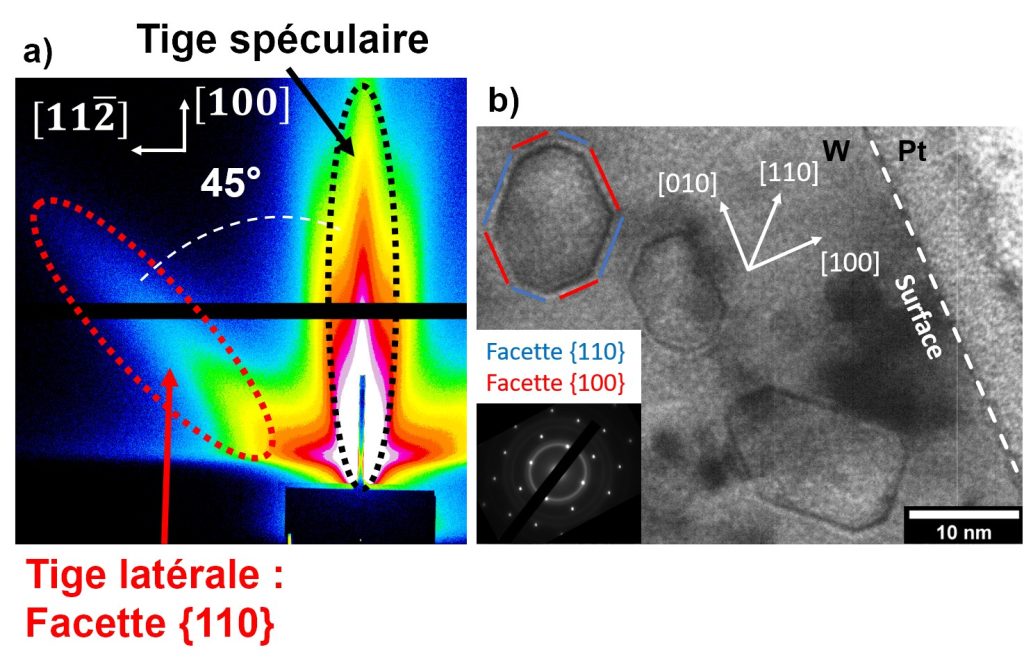In magnetic fusion devices, the components facing the plasma are subjected to energetic particle flows of ions or hydrogen (fuel) atoms and helium (the product of fusion reactions). The helium settles and aggregates in the form of nano-bubbles, which alter the properties of the material in question, such as tungsten. A real-time implantation and characterisation experiment using grazing incidence central X-ray scattering was carried out at the ESRF (European Synchrotron Radiation Facility) synchrotron in Grenoble to better understand the formation of these helium bubbles in tungsten. A world premiere!
In magnetic fusion machines such as WEST and ITER, the plasma facing components must withstand the thermal loads exerted on them continuously or transiently. The divertor, the most exposed component, must withstand thermal loads of 10 MW/m² continuously and 20 MW/m² transiently. These components are also subjected to particle flows consisting of ions or hydrogen atoms (deuterium-D or tritium-T, fusion fuels), helium and neutrons (product of D-T fusion), and impurities.
The low-energy helium (<100 eV) near the divertor settles, aggregates and forms helium nano-bubbles beneath the component’s surface. Modifying the microstructure by these bubbles, both in the volume and on the component’s surface, alters the material’s plasma properties (physical properties and hydrogen retention).
In a fusion machine, thermal loading cycles, associated thermal gradients, the surface chemistry of the components (oxygen, boron, hydrogen, etc.) and their microstructure (polycrystalline, pre-existing crystalline defects) make it difficult to understand the mechanisms of bubble growth and evolution. This calls for a laboratory approach that enables all these parameters to be controlled and evaluated separately. Since 2021, a collaboration between CEA-IRFM, CINaM (Centre Interdisciplinaire de Nanoscience de Marseille), and PIIM (Laboratoire de Physique des Interaction Ioniques et Moléculaires) has been created in this sense.
The aim is to show how helium bubbles form and evolve better to predict their presence and effects on macroscopic properties. To achieve this, tungsten samples were implanted in helium and characterised in real-time by central grazing incidence X-ray scattering [1] (GISAXS – Grazing Incidence Small Angle X-ray Scattering) at the European Synchrotron Radiation Facility (ESRF) in Grenoble. By measuring X-ray scattering and processing the data appropriately, this technique makes it possible to define the shape and size of bubbles over several square millimetres of the sample, unlike transmission electron microscopy (TEM), which gives very local information (~0.1 µm²).
Single-crystal tungsten is studied to dissociate the potential effect of microstructure on the understanding of mechanisms. To control surface finish, samples are prepared at CINaM (minimising surface roughness and contamination).
Helium implantation is carried out at ESRF on the BM32 line using an ion cannon. The ion implantation energy is controlled and raised to 400 eV or 2 keV, respectively, below and above the threshold for creating gaps in tungsten by helium (~1000 eV). Finally, the temperature of the samples is kept constant at various values between ambient temperature and 1000°C (surface temperature of the ITER divertor under standard conditions). This experiment is a world premiere. After implantation, to reproduce the heating undergone during plasma transients, the samples are annealed under ultra-high vacuum up to 1550°C. GISAXS also monitors the influence of thermal annealing in situ.
Figure (a) is an example of a GISAXS image obtained after annealing. The vertical “specular rod” is related to the roughness of the sample. The presence of a lateral rod indicates that the bubble shape is not spherical but faceted. By inclining the rod vertically, we can establish the crystallographic orientation of the facet and, thus, the 3D shape of the bubble [2]. This shows that faceted bubbles comprise {100} and {110} facets. Post-mortem analyses by transmission electron microscopy agree with the results obtained by GISAXS (figure b). They also show that all bubbles have the same facets, indicating they are close to thermodynamic equilibrium. Finally, the width of the lateral stems on the GISAXS images is related to the average size of the facets that generated them. GISAXS can deduce the kinetics and growth mechanisms of helium bubbles in tungsten by analysing the data during implantation.
These results are invaluable in defining the impact of bubble shape and growth kinetics on the loss of tungsten properties.

[1] G. Renaud, R. Lazzari, and F. Leroy, Surf. Sci. Rep. 64, 255 (2009).
[2] L. Corso et al., Nucl. Mater. Energy 37, 101533 (2023).


